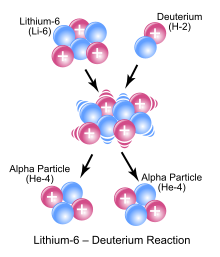Aneutronic fusion is any form of fusion power in which very little of the energy released is carried by neutrons. While the lowest-threshold nuclear fusion reactions release up to 80% of their energy in the form of neutrons, aneutronic reactions release energy in the form of charged particles, typically protons or alpha particles. Successful aneutronic fusion would greatly reduce problems associated with neutron radiation such as damaging ionizing radiation, neutron activation, and requirements for biological shielding, remote handling and safety.
Since it is simpler to convert the energy of charged particles into electrical power than it is to convert energy from uncharged particles, an aneutronic reaction would be attractive for power systems. Some proponents see a potential for dramatic cost reductions by converting energy directly to electricity, as well as in eliminating the radiation from neutrons, which are difficult to shield against.[1][2] However, the conditions required to harness aneutronic fusion are much more extreme than those required for deuterium-tritium fusion being investigated in ITER or Wendelstein 7-X.

Lithium-6–deuterium fusion reaction: an aneutronic fusion reaction, with energy released carried by alpha particles, not neutrons.
Candidate reactions[edit]
Several nuclear reactions produce no neutrons on any of their branches. Those with the largest cross sections are these:
| Isotopes | Reaction | ||||||||
|---|---|---|---|---|---|---|---|---|---|
| Deuterium - Helium-3 | 2D | + | 3He | → | 4He | + | 1p | + 18.3 MeV | |
| Deuterium - Lithium-6 | 2D | + | 6Li | → | 2 | 4He | + 22.4 MeV | ||
| Proton - Lithium-6 | 1p | + | 6Li | → | 4He | + | 3He | + 4.0 MeV | |
| Helium-3 – Lithium-6 | 3He | + | 6Li | → | 2 | 4He | + | 1p | + 16.9 MeV |
| Helium-3 - Helium-3 | 3He | + | 3He | → | 4He | + | 2 1p | + 12.86 MeV | |
| Proton – Lithium-7 | 1p | + | 7Li | → | 2 | 4He | + 17.2 MeV | ||
| Proton – Boron-11 | 1p | + | 11B | → | 3 | 4He | + 8.7 MeV | ||
| Proton – Nitrogen | 1p | + | 15N | → | 12C | + | 4He | + 5.0 MeV | |
Energy capture[edit]
Aneutronic fusion produces energy in the form of charged particles instead of neutrons. This means that energy from aneutronic fusion could be captured using direct conversion instead of the steam cycle. Direct conversion techniques can either be inductive, based on changes in magnetic fields, electrostatic, based on pitting charged particles against an electric field, or photoelectric, in which light energy is captured. In a pulsed mode.[50]
Electrostatic direct conversion uses the motion of charged particles to create voltage. This voltage drives electricity in a wire. This becomes electrical power, the reverse of most phenomena that use a voltage to put a particle in motion. Direct energy conversion does the opposite, using particle motion to produce a voltage. It has been described as a linear accelerator running backwards.[51] An early supporter of this method was Richard F. Post at Lawrence Livermore. He proposed to capture the kinetic energy of charged particles as they were exhausted from a fusion reactor and convert this into voltage to drive current.[52] Post helped develop the theoretical underpinnings of direct conversion, later demonstrated by Barr and Moir. They demonstrated a 48 percent energy capture efficiency on the Tandem Mirror Experiment in 1981.[53]
Aneutronic fusion loses much of its energy as light. This energy results from the acceleration and deceleration of charged particles. These speed changes can be caused by Bremsstrahlung radiation or cyclotron radiation or synchrotron radiation or electric field interactions. The radiation can be estimated using the Larmor formula and comes in the X-ray, IR, UV and visible spectra. Some of the energy radiated as X-rays may be converted directly to electricity. Because of the photoelectric effect, X-rays passing through an array of conducting foils transfer some of their energy to electrons, which can then be captured electrostatically. Since X-rays can go through far greater material thickness than electrons, many hundreds or thousands of layers are needed to absorb them.[54]
See also[edit]
https://en.wikipedia.org/wiki/Aneutronic_fusion

No comments:
Post a Comment